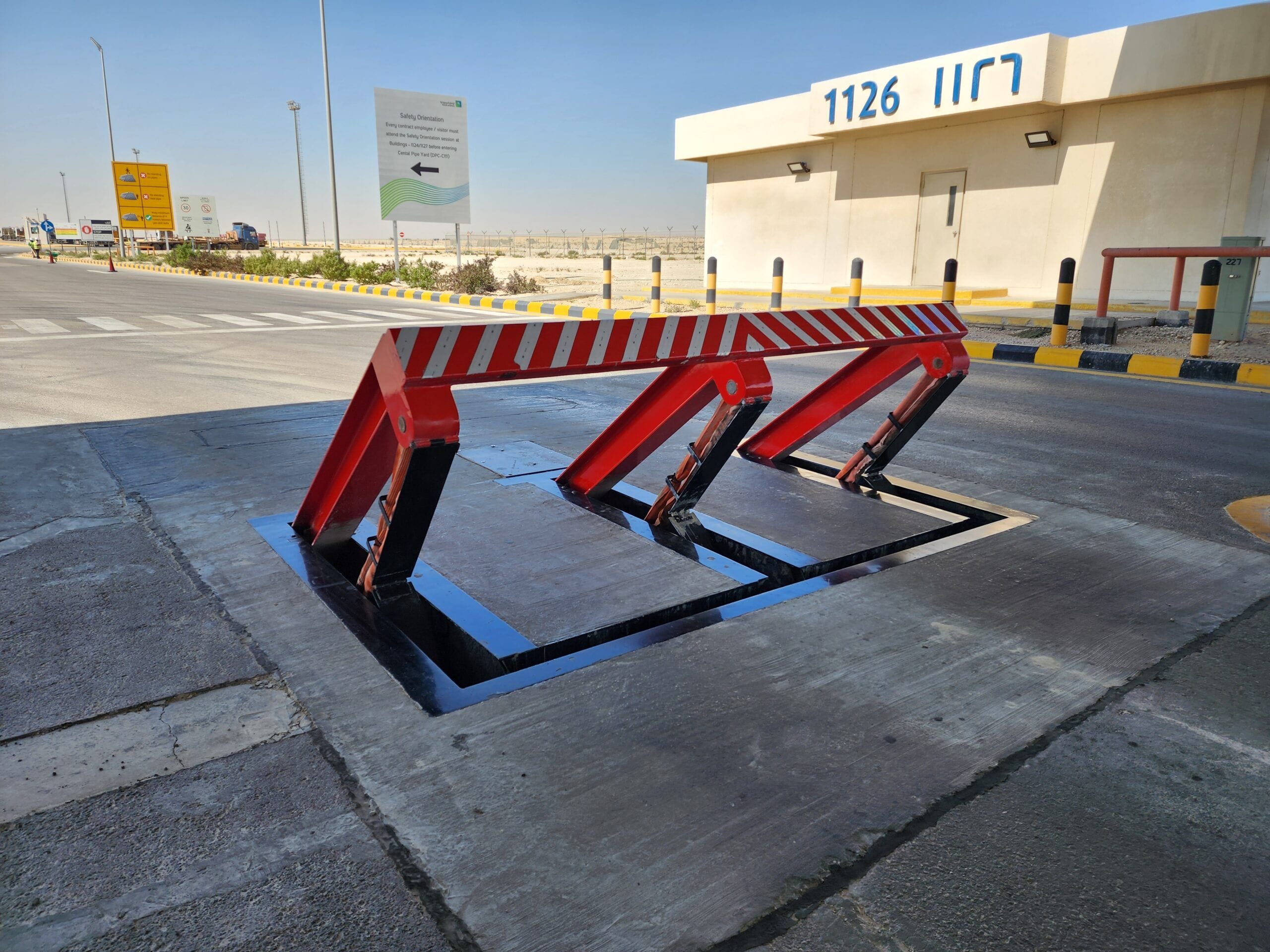Anti-Ram Wedge Barriers: Critical Infrastructure Protection
Anti-ram wedge barriers are installed flush with grade ground-level security systems and designed to physically stop unauthorized vehicles from breaching high-risk areas. Installed flush with the road surface, they rise quickly to form an angled steel barricade strong enough to halt even a heavy truck (15,000LBS) at full speed. Depending on the setup, they can be activated hydraulically for quick deployment, electrically for quieter operation, or manually in low-traffic zones, all offering a reliable way to control access.
These barriers are commonly installed at embassies, government facilities, and corporate sites where both protection and deterrence are critical. Unlike standard gates or fences, a wedge barrier system conveys a clear message of high security, acting not only as a physical barrier but also as a psychological deterrent to potential threats.
Why Critical Infrastructure Needs a Wedge Barrier System
Critical infrastructure, like power plants, airports, and data centers, faces a growing array of physical threats. In recent years, vehicle-ramming incidents have proven just how quickly a determined attacker or negligent driver can breach unsecured perimeters. For facilities that provide essential services to the public, anti-ram barriers are no longer optional, they’re foundational to safety.
Anti-ram wedge barriers serve both as physical protection and as visual deterrents. Their mere presence discourages unauthorized access, making it clear that the site takes perimeter defense seriously. When deployed, they provide immediate impact resistance to fast-moving threats, particularly in exposed entry zones like parking lots, service roads, or vehicle checkpoints.
Key reasons critical infrastructure relies on these barriers include:
- Fast deployment during emergencies or breaches
- Visible deterrence that lowers the likelihood of intrusion
- Prevention of large-scale damage to assets and operations
- Compliance with homeland security or safety mandates
From a risk management standpoint, a vehicle wedge barrier is a high-value safeguard that protects not only the facility, but the people and systems that rely on it.
Design Standards and Crash Ratings for Maximum Security
Anti-ram wedge barriers aren’t all made for the same threats, some stop small cars, while others can take on a speeding 15,000-pound truck. Crash ratings indicate the impact a barrier can withstand, based on real-world testing. With clear standards from ASTM and the Department of State, it’s easier to compare models and know what level of protection you’re getting. Below, you’ll find a simple breakdown of how these ratings work, what the main classifications mean, and how to match the right barrier to your site’s security needs.
Crash Ratings Simplified: When selecting an anti-ram barrier, one of the most important factors is its crash rating. This rating measures the barrier’s ability to stop a specific vehicle weight at a specific speed. The higher the rating, the greater the stopping power.
ASTM and DOS Standards: The most recognized standard today is ASTM F2656, which replaced the older Department of State (DOS) K-ratings. ASTM uses classifications such as M30, M40, and M50, which indicate the ability to stop a 15,000-pound truck traveling at 30, 40, and 50 mph, respectively. These ratings are based on live crash tests that simulate real-world attack conditions.
Choosing the Right Barrier: Facilities must match crash ratings with their actual threat level. An urban government building may need M50-rated barriers, while a warehouse on the outskirts of town may only require M30. Either way, relying on certified, tested barriers ensures that protection is based on verified performance, not guesswork or assumptions.
Integration with Access Control and Perimeter Systems
Security today is more than just walls and cameras, it’s a connected ecosystem. A wedge barrier system, when integrated with access control and surveillance systems, offers a smarter and more responsive form of perimeter defense. It doesn’t just stop a vehicle; it reacts to data in real time, forming part of an intelligent response strategy.
Take, for example, a facility where access is managed through license plate recognition. As a vehicle approaches, cameras scan the plate, cross-reference it with an internal whitelist, and, if authorized, allow the vehicle through without raising the barrier. But if the plate isn’t recognized, the system immediately triggers the wedge to rise, preventing entry while security is notified.
This kind of layered setup offers flexibility for high-security environments. To get it right, organizations should ensure their systems:
- Integrate under a centralized platform for real-time decision-making
- Include backup power to ensure uninterrupted protection
- Are tested regularly through drills and simulated events
When integrated properly, wedge barriers become more than barriers, they become part of an active, intelligent security grid.
Maintenance, Durability, and Long-Term Cost Benefits
Investing in an anti-ram wedge barrier system is a smart move for physical security, but keeping it reliable requires ongoing attention. No matter how tough the design, regular maintenance is essential to keep response times sharp and prevent technical failures. Facilities that neglect servicing often discover too late that their systems don’t perform as expected during real emergencies.
The good news is that well-built barriers are engineered for long-term use. They’re tested in extreme temperatures, weatherproofed against rain and snow, and resilient to wear from frequent cycles. Sites that prioritize inspections, checking for oil leaks, testing electronic sensors, cleaning grit and debris, extend their barrier’s lifespan and reduce repair costs over time.
More importantly, strong preventive maintenance pays dividends:
- Fewer unexpected breakdowns during high-risk events
- Lower operational costs from avoidable repairs
- Increased reliability in critical moments
- Better ROI on initial capital investment
In the long run, anti-ram wedge barriers aren’t just about stopping threats, they’re about protecting everything you’ve invested in behind the line.
Why Choose Black Security Products
Black Security Products is a trusted, U.S.-based provider of advanced perimeter security solutions, boasting over 25 years of experience. Recognized on the U.S. Department of Defense Anti-Ram Vehicle Barrier List (March 2021), BSP offers both passive and active anti-ram systems designed for high-risk environments. Headquartered in Houston, TX with offices in Kalispell, MT, WA and MI, BSP serves a global client base with tailored, mission-ready solutions.
BSP’s wedge barrier systems are more than physical deterrents—they’re intelligent tools that support 24/7 alarm monitoring, advanced traffic control, and seamless integration with access control software. Whether for cost-effective protection or full-scale AT/FP coverage, these systems provide crash-tested performance, real-time responsiveness, and long-term reliability for critical infrastructure.
Even the strongest barriers require proper planning and maintenance. BSP helps clients choose the right system based on their threat profile and ensures long-term durability through expert support. With certified systems and worldwide deployments, BSP is ready to enhance your perimeter defense. Contact us today to schedule a consultation or request a quote.


